Raffaele Passerini • Director
"A story of spurned artists"
- Raffaele Passerini talks about his documentary The Prince, starring two dazed and confused actors in search of redemption. Life Tales Award and Audience Award at Bologna's Biografilm

The famous nudist beach of Capocotta, on the Roman coast, is the theatre of their lives as well as their failed careers. Dario and Maury are two actors who are no longer young and have been spurned by the theatre, the Academy and film, who spend their summers putting together and filming a vast repertoire of scenes for the pleasure of beachgoers in Ostia. Director Raffaele Passerini made them the protagonists of his debut documentary, The Prince [+see also:
trailer
interview: Raffaele Passerini
film profile], an irreverent diary that celebrates redemption from social conventions through creativity, extravagance and poetry, and had its world premiere at the 13th Biografilm Film Festival in Bologna.
Cineuropa: How did you meet Dario and Maury, aka the Prince and the Countess?
Raffaele Passerini: I’m from Cesena, but I lived in New York for eight years. During my time in the United States I would come to the Roman coast every summer, and my friends would take me to Capocotta. 15 years ago I remember seeing this same character, Dario, who would put up a banner every Saturday and put on little performances. And like many, I found him very likeable. Then I came back to live in Rome and started going to the coast more regularly, and two summers ago I saw that Maury in particular used costumes. It seemed like they were doing something I saw in New York at Susan Batson’s acting school, an exercise called “onion peeling”, which involves putting on your public persona when you leave the house and taking it off only when you go to bed. This made me realise that they perhaps weren’t just two people dressing up and clowning around at the beach, but two actors. My instinct was to pitch the idea of making a documentary to them to better understand their world. I filmed over the course of August 2015 and then, once filming was complete, they gave me an archive of all the material they had filmed over 10-15 years, their performances.
Whilst we can see right from the first scenes that the Countess is a failed actress, we only realise this about the Prince later on. Why not tell us earlier on?
That was a choice I made with the editor, Paola Freddi (who has also edited The Wait [+see also:
film review
trailer
interview: Lou de Laâge
interview: Piero Messina
film profile] and Pure Hearts [+see also:
film review
trailer
interview: Roberto De Paolis
film profile], among others), who was brilliant and gave 100% throughout the process. We wanted it to be something you find out gradually. To begin with these people may just seem like two madmen, then we start to see what’s behind that. Everyone has the same preconception, but after a while you start to wonder: perhaps I judged them too soon. Also, as they’re two complex characters with many layers, it took time to really get to the heart of who they are.
And why did you choose to not include the points of views of the people of Capocotta?
In Capocotta, which is an open space, these people are highly respected and well-loved. I discovered that the troubadours of Capocotta have a long history behind them. In the film, Dario mentions people that came before him, like the “Battello Ubriaco”, he’s the latest in a long line. I wasn’t interested in LGBT issues or Capocotta beach itself. I filmed lots of people, but we decided when it came to the editing stage to not use the material, because Dario and Maury are two artists, two poets when it comes down to it. Dario is a performer, a painter, the creator of installations, an actor who loves film and has studied animation. Maury is an actress (or actor, as you like). I wanted to tell a story of spurned artists. My background is very similar to theirs, I was perhaps just more fortunate. Even though this is my debut piece, I have always been able to work, earn a living and travel in this profession. Bu they’ve kept a certain purity to their art. They make do with what they have, including their phobias and aversions, with their financial limitations.
In this regard, viewers will inevitably ask: how do they support themselves?
They have never sacrificed the opportunity to play with their characters every day. It was something they needed, and it made me understand, in a rather American way, that if you want something badly enough you can make it happen, and you should always remain faithful to the nature of your art. They changed a lot in me as a director, they gave me a film. Truth be told, I never asked them how they manage to scrape out a living. The film conveys the playfulness of making films, a certain originality and perhaps even a model. You end up asking yourself: how can I make my life sustainable and have their freedom? They’ve made sacrifices and compromises, they really do live on just a few hundred euros a month. The house of theirs that we see in the film is full of stuff; they’re two hoarders, they admit it and aren’t afraid to show it. And that’s precisely what they taught me: that you shouldn’t be ashamed of showing the world who you are.
(Translated from Italian)
Did you enjoy reading this article? Please subscribe to our newsletter to receive more stories like this directly in your inbox.
















